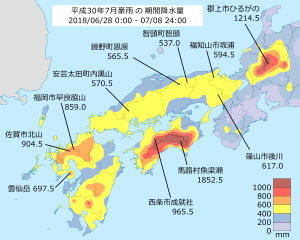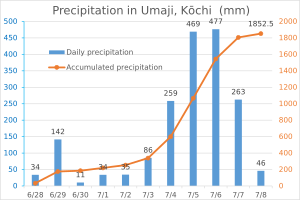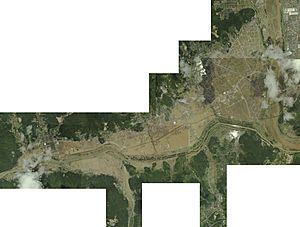2018 Japan floods facts for kids
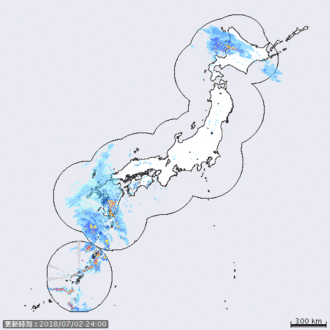
Radar animation of the event from 3–8 July nationwide; the animation starts with Typhoon Prapiroon affecting western areas of the country followed by successive rounds of heavy rain along the Meiyu front
|
|
| Date | 28 June 2018 – 9 July 2018 |
|---|---|
| Location | Japan, primarily Shikoku and western Honshu |
| Deaths | 225 fatalities, 13 missing |
| Property damage | ¥1.09 trillion (US$9.86 billion) |
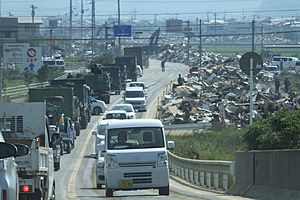
In the summer of 2018, very heavy rain hit southwestern Japan. This caused huge floods and dangerous mudflows. The Japanese government officially calls this event the "Heavy rain of July, Heisei 30."
By July 20, 2018, 225 people had died across 15 areas of Japan. Another 13 people were reported missing. More than 8 million people were told to leave their homes for safety. This was the deadliest flood disaster in Japan since 1982. Back then, 299 people died. About 54,000 members of Japan's military, police, and firefighters worked to find people. They searched for those trapped or hurt by the landslides and floods. The Japanese government also set up a special team to gather information and help.
Contents
How the Floods Happened and Their Impact
On June 28, 2018, a weather system called a Meiyu front became stuck over Japan. This caused many days of heavy rain, especially in northern Kyushu. Then, on July 3, Typhoon Prapiroon brought even more rain and strong winds. The moisture from the typhoon made the rain along the front even worse. This affected Kyushu, Shikoku, and western and central Honshu.
Many areas received over 400 mm (16 inches) of rain in just 10 days. Some places got more than 1,000 mm (39 inches) of rain. The Japan Meteorological Agency (JMA) issued emergency heavy rain warnings for eight areas. This was the largest number of warnings they had ever issued at once. A JMA official said the rain was "at a level we've never experienced."
The huge amount of rain caused many landslides and flash floodings. In some of the worst-hit areas, water levels reached 5 meters (16 feet) high. For example, Motoyama, in Kōchi, got 584 mm (23 inches) of rain in just two days. Another town in Kōchi received 263 mm (10 inches) of rain in only two hours.
After the rain stopped around July 9, high temperatures became a problem. Temperatures reached 30 °C (86 °F). About 11,200 homes had no electricity. This raised worries about heatstroke and a lack of safe drinking water.
In 2018, Hiroshima prefecture had 1,243 mudslides. This is more than the total for the entire country in an average year. Most of these happened during this major rain event.
People Affected
At least 225 people died because of the floods. Most deaths were due to mudslides, landslides, or vehicles being swept away by water. Many people who died had chosen to stay in their homes. They did this even though they were told to evacuate many times.
Police received many calls about people trapped in homes buried by landslides. They also heard about people swept away by swollen rivers or stuck in cars. In Higashihiroshima, at least ten people were buried in their homes. Rescuers confirmed seven of them were alive but still trapped on July 7.
Impact on Businesses
The floods also affected businesses. By July 7, no bullet trains were running west of Shin-Osaka Station. Train officials were not sure when service would restart. Many travelers were stranded, and some bullet trains were used as temporary hotels.
Some car companies, like Mitsubishi Motors and Mazda Motor, stopped making cars. The rain and floods messed up their supply chains. Other companies, such as Daihatsu and Panasonic, closed their factories. They waited for debris to be cleared and water to go down. A factory in Okayama exploded on July 6, but workers had already left due to the flooding.
Delivery companies like Sagawa Express and Yamato Transport also had problems. They reported that some deliveries to and from the affected areas were delayed or stopped. Local supermarkets were also affected. Some stores closed or had shorter hours because products couldn't be delivered.
Japan suffered a lot of damage. The total cost was about ¥1.09 trillion (US$9.86 billion). Damage to farming, forests, and fishing cost ¥629 billion (US$5.69 billion). Damage to public things like roads, railways, and flood walls was ¥465 billion (US$4.21 billion).
Rescue Efforts
Prime Minister Shinzō Abe told his ministers to "make an all-out effort" to rescue victims. Abe called an emergency disaster meeting on July 8. This was the first such meeting since the 2016 Kumamoto earthquakes. Chief Cabinet Secretary Yoshihide Suga said the government set up a special team. They also provided 2 billion yen ($18 million) to quickly deliver supplies to shelters and residents.
About 54,000 people from police, fire departments, the Self-Defense Forces, and the Coast Guard were sent to help. They rescued people stuck in flooded areas. At the peak of the storms, 2.82 million people were ordered to evacuate. Another 4.22 million people were advised to leave their homes across 23 areas. Japanese soldiers went door-to-door in neighborhoods. They checked if residents were safe or needed help.
Rescuers used helicopters and boats to save people trapped on rooftops and balconies. People also used social media to let authorities and family know if they were safe. One woman from Kurashiki, Okayama tweeted for help. She said the water reached the second floor and her kids couldn't get to the roof. In Okayama Prefecture, 1,850 people were rescued from rooftops. At Mabi Memorial Hospital, 160 patients and staff needed to be rescued.
International Help
Many countries offered help to Japan during this difficult time.
 Taiwan : Taiwan announced they would donate 20 million yen for disaster relief.
Taiwan : Taiwan announced they would donate 20 million yen for disaster relief. Thailand : Thailand sent a donation of 17 million yen. The Thai Red Cross Society gave another 7 million yen.
Thailand : Thailand sent a donation of 17 million yen. The Thai Red Cross Society gave another 7 million yen. Philippines : The Philippine Government offered soldiers, engineers, and doctors to help with rebuilding. They also offered medical supplies.
Philippines : The Philippine Government offered soldiers, engineers, and doctors to help with rebuilding. They also offered medical supplies. Singapore : Mercy Relief, a group from Singapore, sent a team to help provide meals. They also started a fundraiser in Singapore.
Singapore : Mercy Relief, a group from Singapore, sent a team to help provide meals. They also started a fundraiser in Singapore. Israel : The Israeli group IsraAID sent a team to help. They gave out important supplies and offered mental health support to those affected.
Israel : The Israeli group IsraAID sent a team to help. They gave out important supplies and offered mental health support to those affected. Malaysia : The Malaysian government donated RM500,000 to the Japanese embassy. This was for flood victims and those affected by a recent heat wave.
Malaysia : The Malaysian government donated RM500,000 to the Japanese embassy. This was for flood victims and those affected by a recent heat wave.
See also
 In Spanish: Inundaciones de Japón de 2018 para niños
In Spanish: Inundaciones de Japón de 2018 para niños


